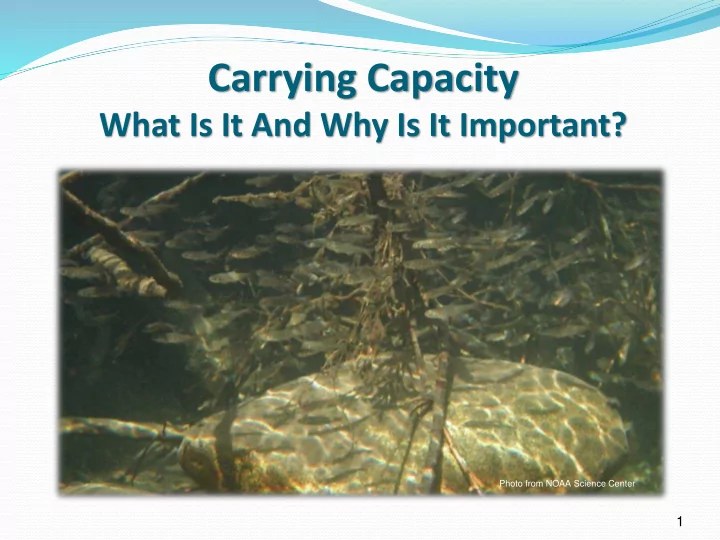

Carrying Capacity What Is It And Why Is It Important? Photo from NOAA Science Center 1
Definition Carrying Capacity = Number of individuals or biomass the resources of a given area can support usually through the most unfavorable period of the year. Maximum Environmental Load Linked to Tolerance Limits and Limiting Factors (aka ecological concerns) Habitat Capacity (C) 2
Definition Population Capacity = Maximum equilibrium population size (K) estimated using population models such as the logistic equation or some stock-recruitment models. Defines an upper limit to population growth as density increases. 3
Population Regulation Density Independent Factors = Population growth is not affected by population density; population persistence is explained by unpredictable environmental variability (Andrewartha and Birch). Density Dependent Regulation = Population growth is affected by mechanisms whose effectiveness increases as population size increases (Nicholson, Lack, and Elton). 4
Evidence of Density Dependence Chiwawa Spring Chinook 1,200 Plot of population size 1,000 and population growth Parr/Spawner 800 rate (or surrogates such as 600 survival rates, natality, 400 productivity, recruits, 200 individual growth rates, 0 0 500 1,000 1,500 2,000 2,500 movement). There is a negative 800 relationship between 700 600 population size and Smolts/Spawner 500 growth rate. 400 300 200 100 0 0 500 1,000 1,500 2,000 2,500 Number of Spawners 5
Methods for Estimating Carrying Capacity Time series analysis Stock-recruitment modeling Habitat modeling 6
Time Series Analysis Plot population size over time. Logistic Growth Logistic function Carrying Capacity 𝐿 K 𝑂 𝑢 = Number 𝐿 − 𝑂 0 /𝑂 0 𝑓 −𝑠𝑢 1 + 𝑒𝑂 𝑒𝑢 = 𝑠𝑂 1 − 𝑂 𝐿 0 Time 7
Stock-Recruitment Modeling Ricker Model 300 Fit Ricker, Beverton-Holt, and Pop 1 Pop 2 250 Smooth Hockey Stick models to Pop 3 Pop 4 Recruits 200 stock (spawners) and recruitment 150 (fry, parr, smolts) data. 100 Ricker: 50 𝑭(𝑺) = 𝜷𝑻𝒇 −𝜸𝑻 0 𝜷 0 200 400 600 800 1000 𝜸 𝒇 −𝟐 𝑳 = Parents Beverton-Holt: Smooth Hockey Stick Model 𝜷𝑻 600 𝑭 𝑺 = 𝜸 + 𝑻 500 𝜷 = 𝑳 Recruits 400 Smooth Hockey Stick: 300 Pop 1 Pop 2 200 𝜷 − 𝑺∞ 𝑻 Pop 3 𝑭(𝑺) = 𝑺 ∞ 𝟐 − 𝒇 Pop 4 100 𝑺 ∞ = 𝑳 0 0 200 400 600 800 1000 Parents 8
Habitat Models Habitat capacity can be estimated as the product of habitat area and fish/habitat relationships. Percent Habitat Saturation Model (PHS) 𝑄𝐼𝑇 = 100 𝑦 𝐸 𝑗 𝑦 𝑈 𝑗 Others include Net Rate of Energy Intake (NREI) models, Habitat Suitability (HSI) models, and Quantile Regression Forest (QRF) models. ISEMP/CHaMP (2015) 9
Assumptions Assume we can define a population unambiguously. Assume that we can measure population size accurately. Assume that we have a biologically relevant time-step over which to measure population growth rate. Assume a uniformity of nature. 10
Chiwawa Spring Chinook Stock-Recruitment Models Chiwawa Spring Chinook 200,000 Stock-recruitment B-H Model Ricker Model 160,000 Number of Parr Hockey Stick functions were fit 120,000 successfully to parr 80,000 and yearling smolt 40,000 data. 0 0 500 1,000 1,500 2,000 Number of Spawners 120,000 B-H Model 100,000 Ricker Model Number of Smolts Hockey Stick 80,000 60,000 40,000 20,000 0 0 500 1,000 1,500 2,000 11 Number of Spawners
Chiwawa Spring Chinook Stock-Recruitment Models Parr: Parameter Population Model Productivity Stock size capacity (K) A B Ricker 271.37 0.0009 114,749 271 1,149 Hockey Stick 11.61 314.44 110,747 314 1,055 Beverton-Holt 144,927.36 416.36 144,927 348 ∞ Smolt: Parameter Population Model Productivity Stock size capacity (K) A B Ricker 149.84 0.0011 50,572 150 917 Hockey Stick 10.75 172.33 46,494 172 809 Beverton-Holt 57,854.21 289.50 57,854 200 ∞ 12
Chiwawa Spring Chinook Ricker Model: Quantile Regression Selecting 90% Reference Interval: Chiwawa Spring Chinook Ricker Model 160,000 Carrying Capacity (K) Mean 140,000 90% RI 120,000 90,557 vs 50,572 Number of Smolts 100,000 Stock Size 80,000 60,000 833 vs 917 40,000 20,000 0 0 500 1,000 1,500 2,000 Number of Spawners 13
Chiwawa Spring Chinook Habitat Model: Quantile Regression Forest Model 14
So What Do We Do With It? Couples Counseling Used in life-cycle models to Managers Researchers predict effects of different (Mars) (Venus) recovery scenarios. Used by hatchery managers to inform supplementation programs. Used by harvest managers to set appropriate escapement and harvest levels. Used by restoration practitioners to guide restoration actions. 15
16
Recommend
More recommend